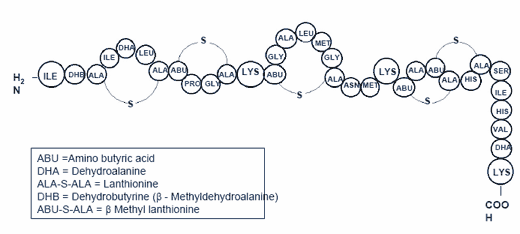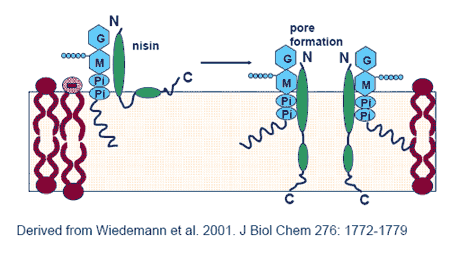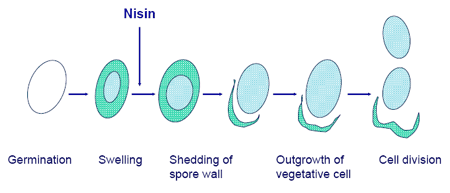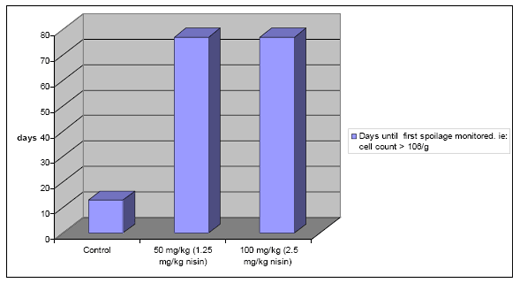Nisaplin® in pasteurised liquid egg
Use of Nisaplin® as a preservative in pasteurised liquid egg products
Published: September 24, 2007
By: Joss Delves- Broughton, Senior Application Specialist, Danisco, UK (Courtesy of the Egg Forum 2007)

It is a mandatory requirement that pasteurised liquid egg products are sufficiently heat processed to ensure the destruction of Salmonella.
However, some bacteria especially those that produce heat resistant spores will survive and grow at low temperatures.
The use of a safe natural preservative that will control the growth of heat resistant bacteria and allow increase in the shelf life of pasteurised liquid egg products would be of considerable interest to the egg industry.
Furthermore some heat resistant bacteria capable of growth at low temperature, notably Bacillus cereus, are food poisoning bacteria and their growth in liquid egg products could present a health hazard and compromise the reputation of the industry.
Nisaplin® is the commercial preparation of the bacteriocin nisin (E234) and is considered a safe and natural preservative.
The presentation will describe the unique properties of nisin and its use a preservative in pasteurised liquid egg.
Nisin use as a preservative in pasteurised liquid egg products has been improved in the USA, Australia, and New Zealand.
In late 2006 the European Food Standard Agency (EFSA) ruled “that the use of nisin in pasteurised liquid egg posed no health hazard”.
The EU will decide whether it can be used as a preservative can be extended for used in pasteurised liquid egg in 2008.
Nisin: history
1930s
Cheesemakers in the UK experienced problems due to an unknowninhibitory substance in milk preventing the growth of starter cultures
1940s
Inhibitory substance was found to be produced by certain strainsof Lactococcus lactis (Lancefield Group N).
Substance isolated & identified as a small antimicrobial polypeptide.
Given the name nisin, derived from “N Inhibitory Substance”
1950s
Lab studies and commercial trials with crude liquid preparations ofnisin.
Found to be unsuitable for medical & veterinary applications.
Some success in controlling growth of gas producing Clostridium incheese.
1960s
Starting point for commercial application & development asa food preservative
Bacteriocins: definition
1930s
Cheesemakers in the UK experienced problems due to an unknowninhibitory substance in milk preventing the growth of starter cultures
1940s
Inhibitory substance was found to be produced by certain strainsof Lactococcus lactis (Lancefield Group N).
Substance isolated & identified as a small antimicrobial polypeptide.
Given the name nisin, derived from “N Inhibitory Substance”
1950s
Lab studies and commercial trials with crude liquid preparations ofnisin.
Found to be unsuitable for medical & veterinary applications.
Some success in controlling growth of gas producing Clostridium incheese.
1960s
Starting point for commercial application & development asa food preservative
Bacteriocins: definition
- Extracellularly released, ribosomally-synthesised, low molecular weight peptides or protein complexes that in low concentrations are able to kill ‘closelyrelated’ bacteria.
- The producer bacteria are immune.
- The most well known bacteriocin is nisin.
- This has broad spectrum activity against Gram positive bacteria.
Nisaplin® Natural Antimicrobial
- A commercial extract of the bacteriocin, nisin
- Standardised potency (106 IU/g ) by addition of salt
- Produced at Danisco’s Beaminster UK site, by a sugar - based fermentation using the dairy starter culture bacterium Lactococcus lactis
- Authorised as a food additive in over 50 countries worldwide. FAO/WHO approval. E234. GRAS status
- Can extend shelf life of food and protect against temperature abuse
- Major applications in processed cheese and pasteurised dairy foods
The realisation of Nisin as a food preservative
Nisin was used as a food preservative because:
Nisin was used as a food preservative because:
- Nisin is non toxic
- The producer strain L. lactis is regarded as safe (food-grade)
- There is no apparent cross-resistance related to therapeutic antibiotics
- It is degraded immediately during digestion
- It is heat stable at low pH
The first commercial preparation of nisin (Nisaplin®) was made in 1953 by Aplin & Barrett Ltd. (now Danisco).
Originally intended only to control clostridial spoilage in processed cheese, the application was so successful it lead to worldwide interest
In 1969 a joint FAO/WHO expert committee on food additives recognised nisin as a safe and legalfood additive
Originally intended only to control clostridial spoilage in processed cheese, the application was so successful it lead to worldwide interest
In 1969 a joint FAO/WHO expert committee on food additives recognised nisin as a safe and legalfood additive
Nisaplin® : composition
| Appearance: Average composition: 2.5% 90% 4% 1.5% 2% Shelf life: | Free flowing white powder nisin sodium chloride protein carbohydrate moisture 2 years at 4°C to 25°C |
Nisin A: structure
Nisin Z contains asparagine instead of histidine at position 27

Nisin mechanism of activity
- Vegetative cells
- Nisin adsorbs to the cytoplasmic membrane where it forms transient pores
- Low molecular weight compounds leak from the cell causing loss of energy
- The pH gradient across the membrane becomes dissipated
- Collapse of the proton motive force (which drives ATP synthesis- the cell’s energy)
Heat-resistant endospores
- Nisin affects spores after germination, preventing their outgrowth
- Does not normally kill bacterial spores
Nisin mode of action against the cytoplasmic membrane
Nisin (
Diagram of cell membrane showing phospholipid bilayer (

Nisin: mode of action against bacterial spores
Inhibition of pre-emergent swelling of spores

What does Nisaplin® do?
- Controls heat-resistant bacteria in pasteurised, sterilised and UHT food products.
- Controls the growth of lactic acid spoilage bacteria
- Controls the growth of Listeria monocytogenes
What it doesn’t do……
- It does NOT control yeast and moulds - Natamax™ can control these
- It does NOT control Gram-negative bacteria
– Usually destroyed by the processes used in manufacture of heattreated foods - It does NOT cover up the use of poor quality raw materials, or poor hygiene
Important considerations to ensure good preservation
- Nisin works in a concentration dependent fashion
- increasing bacterial cell or spore loads will require higher nisin concentrations to achieve effective inhibition - Nisin cannot be used to hide poor manufacturing practice
- Nisin added to a food system will naturally and slowly degrade during shelf life depending on the storage conditions and food type
- For a continued inhibitory or sporostatic effect, there must be sufficient nisin remaining within the food system at the end of the required shelf life
Pasteurised Liquid Egg Products
- Large scale production of liquid whole egg, white and yolk for industrial manufacturers.
- Trend toward whole egg in 1 kg or smaller containers for retail sale/catering supply.
| Ingredients | Raw eggs in shell, egg cracked, white and yolk mixed together, typical pH 7.3 - 7.8. |
| Process | Liquid egg pasteurised, minimum 64.5°C for 2½ minutes (to kill Salmonella spp). "Clean" or aseptic filling into cartons (1kg / 500g / 250g). |
| Products | Retail cartons, chilled (2-4°C) shelf life of 3 weeks or more. |
| Problem | Heat resistant bacterial spores (including Bacillus cereus). Growth during shelf life causing spoilage especially under abuse storage. |
Effectiveness of Nisaplin® in liquid egg

A further trial

EFSA rule on safety
Use of nisin in liquid eggs 'not a safety concern'
By Anthony Fletcher
06/12/2006 - Extending the use of the additive nisin to cover thepreservation of liquid eggs does not pose a safety concern, says EFSA.
Extracted from Food Navigator 2007
Related topics
Join to be able to comment.
Once you join Engormix, you will be able to participate in all content and forums.
* Required information
Would you like to discuss another topic? Create a new post to engage with experts in the community.
Create a post26 de julio de 2016
Where i can have this samples for trial & what is the dosage level in end beverages
26 de julio de 2016
Yes. I would like to have the details on Nisaplin as i would like to use it in Pasteurized liquid egg products.( tailor made beverages with different flavoring ) In that case what is the self life can be extended and what is the storage temp. _ A.P.Moorthy
9 de noviembre de 2015
I would like to speak to a professional,so that i could solve my problem. Is there any contact number?
8 de diciembre de 2011
Good article about Use of Nisaplin as a preservative in pasteurised liquid egg products. I my self i used nisin in pasteurized egg and i succeed to extend the shelf life to 21 days instead of 12 days ,and still the microbial analysis is accepted.










.jpg&w=3840&q=75)